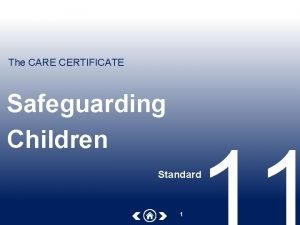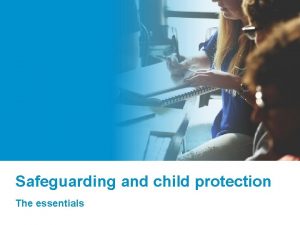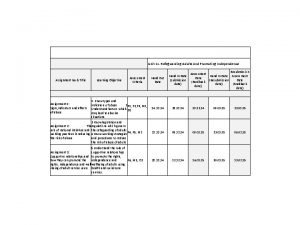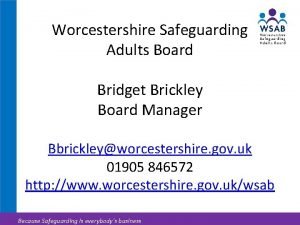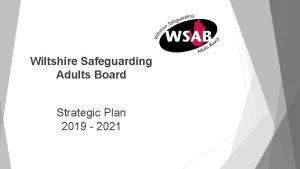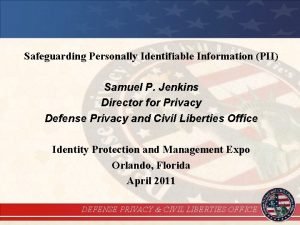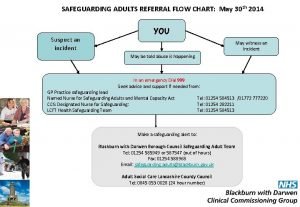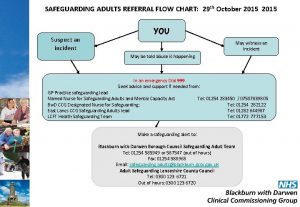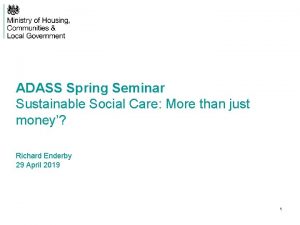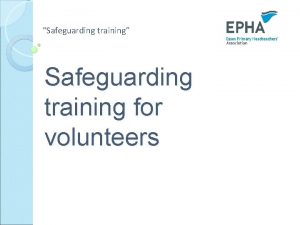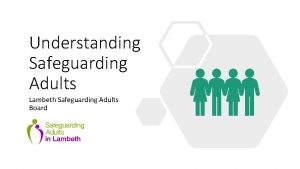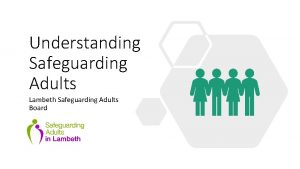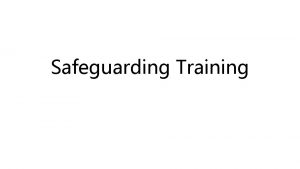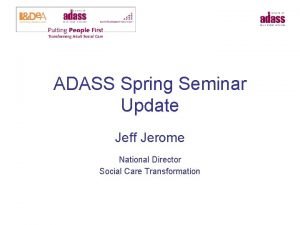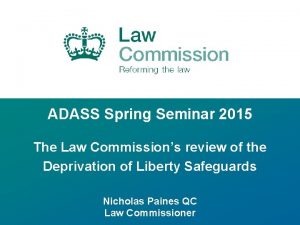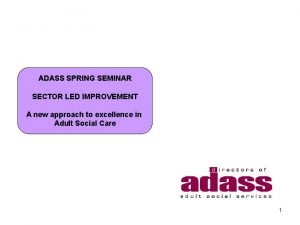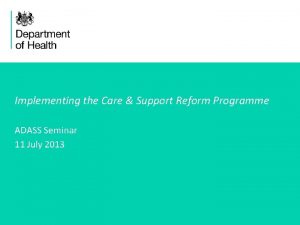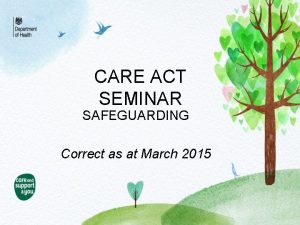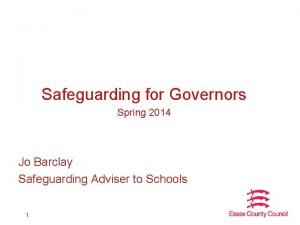Safeguarding and the Care Act ADASS Spring Seminar















- Slides: 15

Safeguarding and the Care Act ADASS Spring Seminar 16 th April 2015 Dr Adi Cooper & Mimi Konigsberg

Key Principles of the Care Act • the person knows best • person’s views, wishes feelings and beliefs should always be considered • the focus is on well-being, prevention or delaying the development of the need for care and support and reducing needs • decisions should be made taking all circumstances into consideration • decisions with the person’s participation • the need to balance the person’s wellbeing with that of family and friends involved with the person • the need to protect people from abuse and neglect • the need to minimise the restriction of rights or freedom of action • a strength based approach is critical to assessment and promoting independence • the need to consider risk and proportionality when deciding how best to respond to safeguarding concerns

Making Safeguarding Personal is explicitly included in the Care Act wellbeing definition includes protection from abuse and neglect as wellbeing in all other areas of life Care Act new function includes the provision of services that prevent care needs from becoming more serious or delay the impact of their needs 6 principles of safeguarding – Culture Change

Six Safeguarding Principles: Empowerment -“I am asked what I want as the outcomes from the safeguarding process and these directly inform what happens next” Prevention - “I receive clear and simple information about what abuse is, signs and what I can do to seek help” how to recognise the Proportionality - “I am sure that the professionals will work in my interest, as I see them and they will only get involved as much as needed” Protection - “I get help and support to report abuse and neglect. I get help so that I am able to take part in the safeguarding process to the extent to which I want” Partnership - “ I know that staff treat any personal and sensitive information in confidence, only sharing what is helpful and necessary. I am confident that professionals will work together and with me to get the best result for me” Accountability - “I understand the role of everyone involved in my life and so do they”

Peer Challenge Message “Peer challenges highlight that people tend not to be asked the outcomes they want. Often they want more than one outcome, which are sometimes not easy to reconcile. People generally want to feel safe but also to maintain relationships. For some people the only human contact they have is with the person/people who is/are harming/abusing them” Peer review messages LGA June 2013

Making Safeguarding Personal The response -A simple message ‘Making safeguarding personal is about engaging with people about the outcomes they want at the beginning and middle of working with them and the ascertaining the extent to which those outcomes were realised at the end. ’ ‘To do this, a mix of responses is required to enable people to achieve resolution or recovery and access to justice’ LGA June Peer Review 2013

What Making safeguarding Personal can do • MSP enables safeguarding to be done with, not to people • MSP focuses on achieving meaningful improvement to people’s circumstances rather than just on ‘investigation’ and ‘conclusion’ • MSP should utilise social work skills better than just putting people through a process • MSP should enable practitioners, families, teams and SABs to know what difference MSP has made in outcomes for people

A strategic approach to MSP • providing clear leadership in each agency working in safeguarding including elected members. • ensuring partner agencies are well-informed • introducing person-centred, outcome-focused practice to safeguarding is a cultural change that needs wide ownership • recognising that partnership engagement in this culture shift is crucial • building on existing good practice e. g personalisation • working across regions to deliver consistency of practice and procedures and workforce development • mainstreaming this approach as good social work practice

Operational approach to MSP • personalised information, advice and guides and language • safeguarding and MARAC meetings –participation and an outcomes focus • documentation – promote person centred practice and gather and report on quantitative and qualitative evidence • link to engagement and awareness raising – prevention • address the use and commissioning of advocacy services • focus on MCA and Do. LS • understanding positive approaches to risk and supported decision making • encourage people to think about recovery as well as resolution using a range of creative responses

Making Safeguarding Personal How to deliver a person-centred, outcome focused approach? Key Questions for Practitioners: • What difference (outcome) is wanted or desired? • How can we work with people to enable that to happen? • How do we know outcomes have been understood and our intervention has made a difference ? • Does the person feel safer and protected ?

Making Safeguarding Personal Toolkit What is it ? The updated toolkit provides a range of models, theories, approaches, skills, areas of specialism which are already common but not used in the safeguarding context Some approaches have been established in just a small number of pioneering council areas Some development work is needed to customise to adult safeguarding How can it be used ? A practitioner guide, a resource for service development, a tool to stimulate innovation Examples include (from a longer list): Use of family and networks, including group conferences Building resilience, confidence, assertiveness, self-esteem Attachment based approaches Motivational interviewing and cycles of change

Implementation The fundamental shift revolves around professional practice; practice that puts the adult and their wishes and experience at the centre of safeguarding enquiries and which seeks to enable people to resolve their circumstances, recover from abuse or neglect and realise the outcomes that they want “it is not business as usual”

Making Safeguarding Personal achievements 2009/10: Literature review 2010/11: A Toolkit of Responses developed 2012/13: 5 Councils were ‘test beds’ 2013/14: 53 Councils actively participated 2014/15: Mainstreamed to all Councils with start up workshops 9 ADASS regional conferences 2 workshops for Safeguarding Adult Board Chairs Ri. Pf. A evaluation (publication due in June 2015) Updated MSP toolkit Journal of Adult Protection Special Issue (June 2015) DH/HSCIC work with IT providers Support to individual L. A. ’s and SAB’s Updated LGA Domestic Abuse guide

Emerging Issues • leadership- national, regional and local-role of the DASS • how to engage partners / providers and align a MSP approach • how best to measure outcomes and ensure quality • managing Do. Ls/MCA workload pressures • commissioner/provider issues-stronger links + CCG’s, CQC, QSG’s • how to work with risk and engage Members on the dilemmas • workforce development -social workers and trainers • IT systems-support not hindrance • newer areas e. g. self-neglect and how to respond • balance of procedures and professional judgement • consumer/citizen engagement

Questions for discussion How are you embedding Making Safeguarding Personal forward? What support do you need? What can you offer? What issues are there for you in implementing the adult safeguarding aspects of the Care Act? Our Top Tips?
 Spring summer fall winter and spring cast
Spring summer fall winter and spring cast Spring and fall months
Spring and fall months Safeguarding children care certificate
Safeguarding children care certificate Levels of care primary secondary tertiary
Levels of care primary secondary tertiary Macbeth act 2 summary
Macbeth act 2 summary Personal care products seminar
Personal care products seminar Act 2 crucible discussion questions
Act 2 crucible discussion questions North spring primary school
North spring primary school Safeguarding and child protection the essentials
Safeguarding and child protection the essentials Unit 11 safeguarding adults and promoting independence
Unit 11 safeguarding adults and promoting independence Health and social care values unit 2
Health and social care values unit 2 Worcestershire safeguarding board
Worcestershire safeguarding board Wiltshire safeguarding adults
Wiltshire safeguarding adults Safeguarding pii
Safeguarding pii Safeguarding referral flowchart
Safeguarding referral flowchart National referral mechanism-flowchart
National referral mechanism-flowchart


